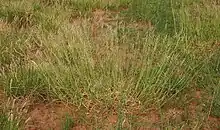| Urochloa trichopus | |
|---|---|
 | |
| Urochloa trichopus (formerly Urochloa mosambicensis) | |
| Scientific classification | |
| Kingdom: | Plantae |
| Clade: | Tracheophytes |
| Clade: | Angiosperms |
| Clade: | Monocots |
| Clade: | Commelinids |
| Order: | Poales |
| Family: | Poaceae |
| Subfamily: | Panicoideae |
| Genus: | Urochloa |
| Species: | U. trichopus |
| Binomial name | |
| Urochloa trichopus | |
| Synonyms[1] | |
|
List
| |
Urochloa trichopus, bushveld signal grass is a species of grass that is native to tropical and southern parts of Africa, Arabian Peninsula and western Madagascar.
Description
It is clump-forming grass that can grow up to 1.7 m (5 ft 6.9 in) meters tall, with alternate spaced leaves. The leaf sheath is glabrous (hairless) to slightly pubescent (having small hairs). The leaf blade is linear, acuminate (tapering to a long point) and 5–30 mm (0.2–1.2 in) long and 5–20 mm (0.2–0.8 in) wide. The flower consists of 3–20 racemes carried on a central axis 4–20 cm (1.6–7.9 in) long. They are solitary, ovate shaped spikelets on a narrowly winged rachis (shaft). They are 2-flowered with lower floret male and upper bisexual. They have 3 stamens. The ovary has 2 plumose (having feathers or featherlike growths) stigmas. The seed capsule is a strongly flattened caryopsis (grain).[2] It fFlowers and fruits between June and August.[3]
Distribution

It is native to the African countries of Angola, Botswana, Burkina, Cameroon, Chad, Congo, Eritrea, Ethiopia, Ivory Coast, Kenya, Malawi, Mali, Mauritania, Mozambique, Namibia (and Caprivi Strip), Niger, Nigeria, Senegal, Somalia, South Africa (within the Cape Provinces, Free State, KwaZulu-Natal and the Northern Provinces), Sudan, Swaziland, Tanzania, Uganda, Zambia, Zaïre and Zimbabwe. In Arabia it is found in Saudi Arabia and Yemen.[1]
It has been found in Telangana state, India in 2021.[3]
It is found at an altitude of up to 1,500 m (4,900 ft) above sea level, in semi-arid climates, in grassland and savanna woodland. It is also found in disturbed locations and as an arable weed.[2]
Taxonomy
It was previously known as Urochloa mosambicensis (with common names of sabi grass and gonya grass).[4][5] Urochloa trichopus
It was first published and described as Urochloa pullulans in D.Oliver & auct. suc. (eds.), Fl. Trop. Afr. vol.9 on page 589 in 1920, before later being called Urochloa trichopus.[1]
It is class as Least Concern on the Red List of South African Plants.[6]
Uses
The seed of Urochloa trichopus can be gathered for food, such as in Kordofan (Sudan), Tanzania, Botswana and Zimbabwe. While, in Botswana it is ground into a flour, which can then be as a cereal, which can be mixed with water, milk or melon juice and made into cake.[2]
It is as good fodder in India.[3]
References
- 1 2 3 "Urochloa trichopus (Hochst.) Stapf | Plants of the World Online | Kew Science". Plants of the World Online. Retrieved 5 October 2023.
- 1 2 3 "Urochloa trichopus (PROTA)". PROTA - Plant Resources of Tropical Africa. Retrieved 5 October 2023.
- 1 2 3 Siddabathula, Nagaraju; Yadav P., Bharath Simha (July 2021). "Urochloa trichopus Stapf, an addition to the flora of Telangana state, India". International Journal of Advanced Research in Science, Engineering and Technology. 8 (7). ISSN 2350-0328.
- ↑ "Urochloa mosambicensis Sabi grass, Gonya grass, Bushveld signal grass PFAF Plant Database". pfaf.org.
- ↑ "Urochloa mosambicensis | PlantZAfrica". pza.sanbi.org.
- ↑ Raimondo, D.; von Staden, L.; Foden, W.; Victor, J.E.; Helme, N.A.; Turner, R.C.; Kamundi, D.A.; Manyama, P.A. (2009). "Red List of South African Plants". Strelitzia. Pretoria: South African National Biodiversity Institute. 25.